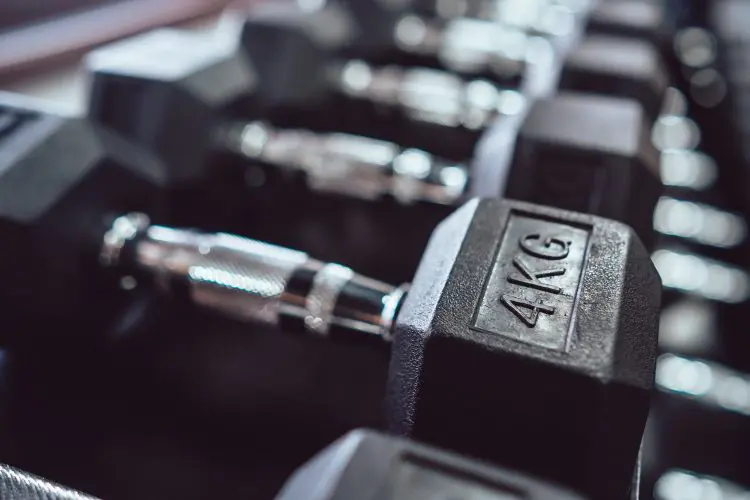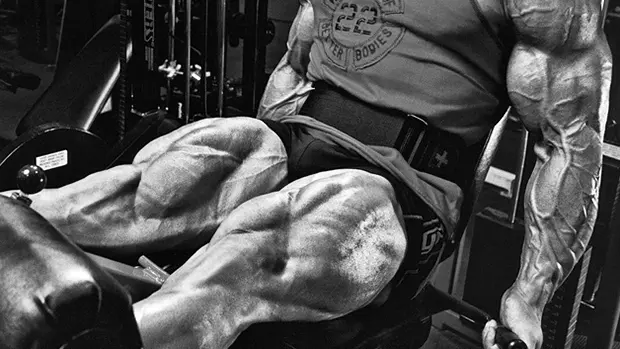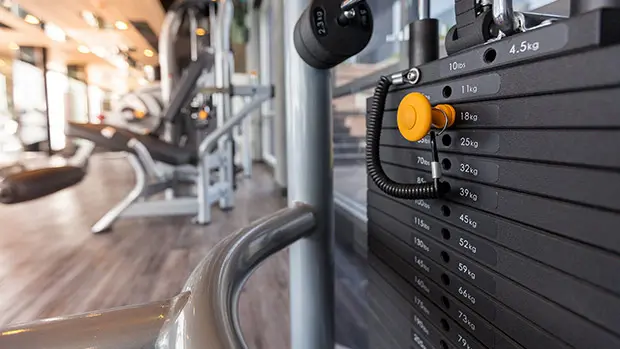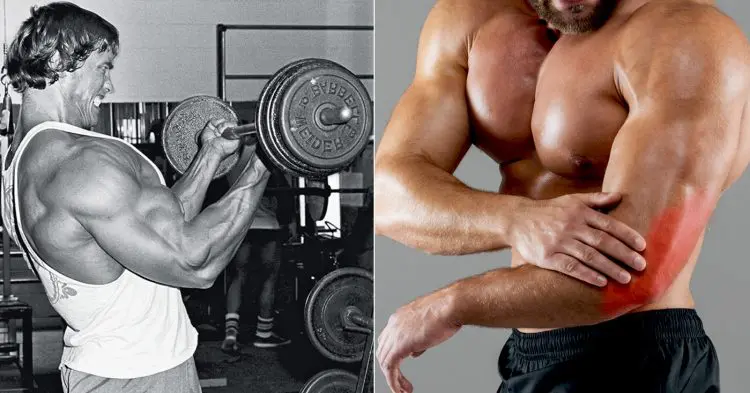Drop sets are a type of training system. Bodybuilders and people who strength train use training systems to increase workout intensity and volume to get better results in less time.
Examples of training systems include supersets, trisets, giant sets, pyramids, reverse pyramids, forced reps, and negative reps.
However, despite having so many training systems to choose from, many lifters prefer to keep things simple and use a method called drop sets to make their workouts more intense and productive.
This article will explain why and how to use drop sets and provide you lots of examples of the best way to use this popular training tool.
What Are Drop Sets?
In simple terms, a drop set is a technique that allows you to train beyond muscular failure. Training past failure increases muscle damage and causes a lot of metabolic fatigue. Using drop sets also increases time under tension and produces a dramatic pump effect. All of these factors increase your potential for hypertrophy.
Level Up Your Fitness: Join our 💪 strong community in Fitness Volt Newsletter. Get daily inspiration, expert-backed workouts, nutrition tips, the latest in strength sports, and the support you need to reach your goals. Subscribe for free!
This is what a basic drop set might look like. Imagine you are doing barbell biceps curls:
10 reps @ 60lbs (can’t manage an 11threp)
Reduce the weight
6 reps @ 50lbs (can’t manage a 7threp)
Reduce the weight
5 reps @ 40lbs (can’t manage a 6threp)
This constitutes a double drop set. I.e., you have reduced (dropped) the weight twice.
It’s these post-failure reps that really crank up the intensity of your workout. After all, if you hadn’t used the drop set system, your set would have stopped after ten reps. Using drop sets, you managed to pump out many more reps, pushing your muscles to new levels of growth.
To “knock off” more muscle fibers, it is imperative that you don’t rest long between drops. Resting too long will allow the muscle fibers you have just fatigued, to start recovering, undoing some of the benefits of training to failure.
Instead, you should try and reduce the weight and get back to repping in 5-15 seconds. Resting longer than this will make this training system less effective and efficient. Because of this, some exercises are better for drop sets than others.
For example, selectorized machines, dumbbells, and fixed weight barbells are perfect for drop sets, whereas a plate- loaded Olympic barbell is not as it may take you to long to strip off the required amount of weight. You can use drop sets with compound and isolation exercises.
How Do Drop Sets Work?
When you lift weights, your set usually comes to an end when you are unable or unwilling to do any more reps. This is the point of momentary muscular failure. However, your muscles aren’t completely exhausted. Instead, they’re only too tired to do more reps with the weight you are using.
For example, if you are lifting 100lbs and come to failure, all that has happened is that you are too tired to generate more than 100lbs of force. You still have muscle fibers that are unfatigued. Not training these muscle fibers means your set is not as productive as it could be.
Reducing the weight and pushing out more reps allows you to hit those muscle fibers that are still able to generate force. You can go on to repeat these weight drops until you have exhausted virtually every fiber of the muscle you are working. Despite lowering the weight, it won’t really feel that much lighter, as you’ll be working with fewer muscle fibers.
All this extra work creates much more muscle microtrauma and metabolic damage, which, providing you pay attention to rest and recovery, should mean you get better results from your workouts.
How Big Should The Drops Be?
Weight reductions during drop sets are a hotly debated topic, and the recommended reductions can vary from as little as 5% up to 50%. It’s not really THAT important how much you reduce the weight by. So long as you drop it and pump out a few reps beyond failure, it will work.
In many cases, the weight drops will be determined by what equipment you are training with. For example, if you are training on a selectorized weight-training machine, like a chest press, you will have to work with whatever increments are on the weight stack.
Similarly, if you are working with dumbbells, you won’t be able to be overly precise with your drops. It’s a case of dropping one set of dumbbells and grabbing the next available pair. You won’t be able to stick to specific percentages.
That said, there are two basic approaches to weight election for drop sets: tight drop sets and wide drop sets.
With tight drop sets, you reduce the weight by a small amount, usually about 10-20%. This allows you to do more reps with heavier weights, making it a useful option if you want to increase strength as well as muscle size. For example, you could do dumbbell curls with 50, 45, 40, and 35lbs.
Using wide drop sets, you reduce the weight by more, usually around 30-40%. This allows you to do more reps per drop and is a good method for pure hypertrophy and muscular endurance.
For example, you might load the leg press with three 45lbs per side to total 270lbs. Rep out with the 270 and, on reaching failure, have two buddies remove one 45lb from each side, leaving you with 180lbs – a 33% drop. Rep out again and, on hitting failure for the second time, strip off another pair of 45s to leave you with just 90lbs. Rep out to failure one more time.
You can also combine these methods by starting off with tight drops and then doing a final wide drop to really go for the burn and chase the pump. For example:
- 50lbs x 8 reps
- 45lbs x 6 reps
- 40lbs x 5 reps
- 20lbs x 10 reps
How Many Times Should I Reduce The Weight?
You can do any number of drops; it all depends on your starting weight, the increments you have available, whether you are using tight or wide drops, and your tolerance to pain and work!
Level Up Your Fitness: Join our 💪 strong community in Fitness Volt Newsletter. Get daily inspiration, expert-backed workouts, nutrition tips, the latest in strength sports, and the support you need to reach your goals. Subscribe for free!
For example, you could lower the weight just once and leave it at that. You will still have taken your set beyond failure and made your workout more productive. Alternatively, you could keep lowering the weight in very small increments until you are using the lightest weights available, maybe even an empty barbell, 5lbs dumbbells, or the lowest weight on the weight stack.
The heavier you start and the smaller the drops, the more times you’ll be able to reduce the weight. Conversely, if you’re using light weights or wide drops, you won’t be able to reduce it as often.
Try not to get too bogged down in the minutia of drop set training. It doesn’t have to be complicated and may not precisely fit any predetermined workout strategy. Instead, make this system work for you by modifying it to your needs, the weights and exercises you are using, and how you feel on the day of your workout. Rep out, drop the weight, and rep out again. Drop sets don’t need to be much more complicated than that.
Mechanical Advantage Drop Sets
Drop sets usually involve reducing or dropping the weight. After all, that’s where they get their name. Decreasing the weight allows you to pump out more repetitions and go beyond your usual failure point.
However, there is another way to train past failure, and it’s called mechanical drop sets.
Simply put, this method involves moving from a weak position to a stronger one. The exercise remains more or less the same, but you should find you can pump out a few more reps as you move from one variation to the next.
Here are a few examples:
- Feet elevated push-ups
- Feet on floor push-ups
- Hands on bench push-ups
Or:
- Overhead barbell squats
- Front squats
- Back squats
Or:
- Strict military press
- Push-press
- Split jerks
Or:
- High incline dumbbell bench press (45 degrees)
- Moderate incline dumbbell bench press (15 degrees)
- Flat dumbbell bench press (0 degrees)
- Decline dumbbell bench press (-15 degrees)
Or:
- Wide grip overhand pull-ups
- Neutral grip chin-ups
- Narrow grip underhand chin-ups
Or:
- Snatch grip barbell deadlift
- Romanian deadlift
- Conventional deadlift
Or:
- Reverse dumbbell curls
- Hammer dumbbell curls
- Regular dumbbell curls
- Cheat curls
With all these examples, the weight remains the same, and you should do as many reps as you can of each exercise. Simply transition from the hardest to the easiest movement to increase time under tension and metabolic stress.
This is a useful method for anyone who trains alone, has limited weight increments available, or simply wants an alternative to standard drop sets.
When To Use Drop Sets?
Drop sets are so easy to add to your workout program that you can use them almost whenever you want. Good opportunities to use drop sets include:
On the last set of each exercise in your workout – make sure you’ve hammered every available muscle fiber by taking your last set beyond failure. Do 2-4 regular sets, and then go “all in” on your final one.
The last exercise for the targeted muscle group – do your initial exercises as usual, and then do drop sets for your final exercise. For example:
- Barbell bench press – 4 sets of 6 reps
- Incline dumbbell bench press – 3 sets of 8 reps
- Dips – 3 sets of 8 reps
- Pec deck – 3 sets of 12 reps plus drop sets
One workout per week – over the course of a month or so, include drop sets in each of your workouts. For example:
| Mon | Tue | Wed | Thu | Fri | Sat | Sun | |
| Chest | Back | Legs | Rest | Shoulders | Abs and arms | Rest | |
| Week 1 | Drop sets | ||||||
| Week 2 | Drop sets | ||||||
| Week 3 | Drop sets | ||||||
| Week 4 | Drop sets | ||||||
| Week 5 | Drop sets |
When you are short on time – if you want to train but don’t have time for a high-volume workout, drop sets can help. They’re so intense that you won’t need to do lots of sets of several different exercises to train your muscles. Instead, use drop sets to fatigue your body in double-quick time. After all, you can’t train harder than beyond failure!
At the end of a training cycle before a deload – make sure you’ve earned your deload by using drop sets during the lead up to your break from training. This is called overreaching and should mean you bounce back bigger and stronger after you’ve had a week away from the gym.
Just because you feel like it – we all have days when we’re feeling unexpectedly strong or energetic. Maybe it’s that new pre-workout you’re using! Whatever the reason, put that energy to good use and add some drop sets to your workout. You won’t need to change any other part of your workout; just “bolt-on” a few drop sets and pump up the intensity of your workout to the max!
Drop Set Drawbacks
Drop sets are one of the safest training systems you can use. After all, you reduce the weight as you start to get tired, which means less stress on your joints, muscles, ligaments, and tendons. The chances of injury are pretty low. In contrast, methods like negatives and forced reps mean working out with heavy weights despite being fatigued.
That said, drop sets do have a few drawbacks…
Overuse injuries
Doing more reps of the same exercise could lead to localized inflammation and joint pain. After all, instead of doing just 6-12 reps per set, you could end up doing 20-30 reps instead. If doing lots of reps of the same exercise causes elbow, shoulder, or knee pain, take care to use and not abuse drop sets by using them infrequently.
Increased fatigue and muscle soreness – drop sets are effective because they allow you to train past failure. Of course, such a dramatic increase in workout intensity means doing drop sets take a lot out of your body. If you use drop sets, you should expect an increase in post-exercise muscle soreness and fatigue, and you may take longer to recover between workouts.
Not so useful for strength – drop sets are better for hypertrophy than they are for pure strength. Invariably, drop sets involve moderate to light weights and moderate to high reps. To develop strength, you need to work with heavy weights and low reps.
You could conceivably do strength-based drop sets, but this isn’t a common training method, and is probably impractical for most exercisers. For example, doing squats, bench presses, or deadlifts:
- 1 rep 200lbs
- 1 rep 180lbs
- 1 rep 160lbs
- 1 rep 150lbs
- 1 rep 140lbs
That said, you could always try and emulate Eddie Hall and attempt his up and down the rack deadlift feat. Watch this and be prepared to be amazed!
Easy to abuse – drop sets are so simple to implement that it would be easy to overuse this training method. After all, what could be more straightforward than going down the rack for dumbbell curls or down the stack on leg extensions?
But, just because you can do drop sets so conveniently doesn’t mean you should use them all the time. Like any training system, they should be used sensibly, and not constantly. You run the risk of overtraining if you use drop sets too frequently.
Drop Sets – Wrapping Up
Drop sets are a powerful training method that is also easy to implement. You can often do drop sets on your own, and they are easy to modify according to your needs, the equipment you are using, and how you feel on the day. You can add them to your workout with very little prior planning and, in fact, choose to do a drop set as you are working out.
But, because they’re so simple to do, it’s easy to forget that even a couple of drops will take your muscles far beyond failure, causing a lot of muscle microtrauma and metabolic fatigue. Drop sets are HARD, so you’ll need to pay extra attention to recovery if you use this training method.
That said, for ease and effectiveness, drop sets are hard to beat. Use them to crank up workout intensity to the max, and get better, faster results from your training.
















